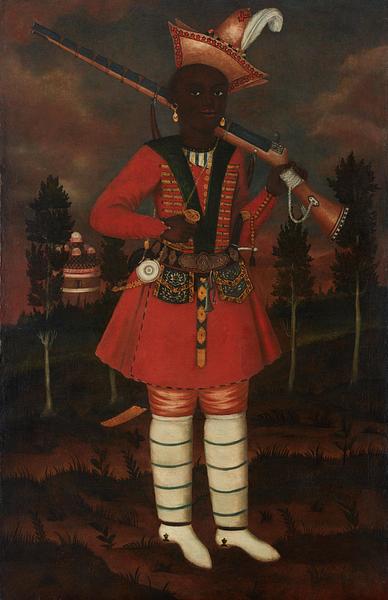The young, black soldier wearing his hat at a rakish angle is well armed. Across his shoulder he carries a matchlock gun, its long fuse extending from and wrapped around the butt of the gun. A fire striker used to ignite the fuse hangs from a hook on his narrow belt. The white, circular container and a similar dark one behind it on his right side presumably held the two types of gunpowder used for such a gun. He also carries a sabre and a dagger, and while his lower legs may appear to be clad in striped socks, they are in fact covered in puttees.
In the background we see a pigeon tower of the type built in large numbers in and around Isfahan from the beginning of the seventeenth century to produce fertiliser for agriculture.
The
Soldier belongs to a small group of a total of twenty-four known Safavid oil paintings from approximately 1650–1725.
[1] In terms of format and subject matter, they have a strong kinship with murals from the same period, several of which still adorn princely palaces in Isfahan and Armenian houses in nearby New Julfa.
[2] These paintings depict figures, are often created as pairs, and show an ethnically, religiously and socially varied gallery of characters that presumably reflects real-life Isfahan at the time.
Several figures appear in Europeanised interiors, others are depicted in relatively empty landscapes which still, due to the use of perspective, reveal an European influence. All in all, these relatively large formats are a result of the impact of European painting, which also found expression within the much smaller formats of the period’s miniature painting (
162/2006).
The depictions include slaves, such as Georgians holding bottles, ready to pour wine for their masters. In all likelihood, the black soldier shown in 7/2021 was in a similar position: a slave soldier attached to the Safavid army’s special corps of musketeers.
